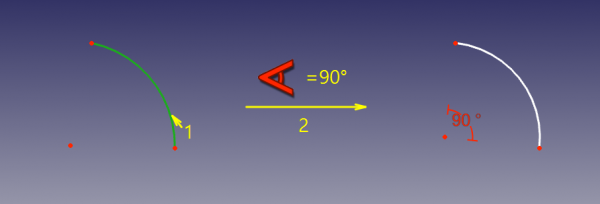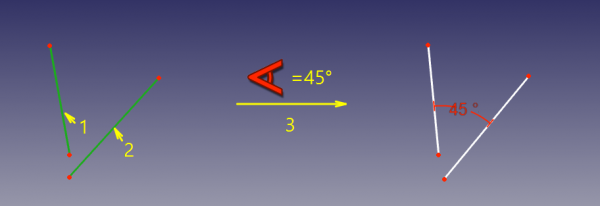Sketcher ConstrainAngle: Difference between revisions
(Docnav) |
(WIP) |
||
| Line 1: | Line 1: | ||
<languages/> |
<languages/> |
||
{{Page_in_progress}} |
|||
<translate> |
<translate> |
||
| Line 28: | Line 29: | ||
==Usage== <!--T:5--> |
==Usage== <!--T:5--> |
||
See also: [[Sketcher_Workbench#Drawing_aids|Drawing aids]]. |
|||
<!--T:29--> |
|||
There are four different ways the constraint can be applied: |
|||
* to individual lines |
|||
* between lines |
|||
* to intersections of curves |
|||
* to arcs of circles |
|||
===[[Sketcher_Workbench#Continue_modes|Continue mode]]=== |
|||
<!--T:6--> |
|||
To apply angle constraint, one should the follow the steps: |
|||
# Make sure there is no selection. |
|||
# Select one, two or three entities in the sketch. The mode will be chosen depending on the selection. |
|||
# There are several ways to invoke the |
# There are several ways to invoke the tool: |
||
#* {{Version|0.22}}: If the {{MenuCommand|Dimensioning constraints}} [[Sketcher_Preferences#General|preference]] is set to {{Value|Single tool}} (default): press the down arrow to the right of the {{Button|[[Image:Sketcher_Dimension.svg||x16px]][[Image:Toolbar_flyout_arrow.svg|x16px]]}} button and select the {{MenuCommand|[[Image:Sketcher_ConstrainAngle.svg|16px]] Constrain angle}} option from the dropdown. |
|||
#* |
#* If this preference has a different value (and in {{VersionMinus|0.21}}): press the {{Button|[[Image:Sketcher_ConstrainAngle.svg|16px]] [[Sketcher_ConstrainAngle|Constrain angle]]}} button. |
||
#* Select the {{MenuCommand|Sketch → Sketcher constraints → [[Image:Sketcher_ConstrainAngle.svg|16px]] Constrain angle}} option from the menu. |
#* Select the {{MenuCommand|Sketch → Sketcher constraints → [[Image:Sketcher_ConstrainAngle.svg|16px]] Constrain angle}} option from the menu. |
||
#* {{Version|0.22}}: Right-click in the [[3D_view|3D view]] and select the {{MenuCommand|Dimension → [[Image:Sketcher_ConstrainAngle.svg|16px]] Constrain angle}} option from the context menu. |
#* {{Version|0.22}}: Right-click in the [[3D_view|3D view]] and select the {{MenuCommand|Dimension → [[Image:Sketcher_ConstrainAngle.svg|16px]] Constrain angle}} option from the context menu. |
||
#* Use the keyboard shortcut: {{KEY|K}} then {{KEY|A}}. |
#* Use the keyboard shortcut: {{KEY|K}} then {{KEY|A}}. |
||
# The cursor changes to a white cross with the tool icon. |
|||
# A datum edit dialog box pops up. |
|||
# Do one of the following: |
|||
# Modify the angle if necessary. '''Note:''' The angle can be entered as an expression that will be evaluated and the result will be stored. |
|||
#* Select two lines. |
|||
# Click {{Button|OK}} |
|||
#* Select a point and two edges (in that order). |
|||
#* Select an edge, a point and an edge (idem). |
|||
# If a [[Sketcher_ToggleDrivingConstraint|driving constraint]] is created, and the {{MenuCommand|Ask for value after creating a dimensional constraint}} [[Sketcher_Preferences#Display|preference]] is selected (default): |
|||
## A dialog opens to edit the constraint value. |
|||
## Press the {{Button|OK}} button to confirm. |
|||
# A constraint is added. |
|||
# Optionally keep creating constraints. |
|||
# To finish, right-click or press {{KEY|Esc}}, or start another geometry or constraint creation tool. |
|||
===Once-only mode=== |
|||
# Do one of the following: |
|||
<!--T:7--> |
|||
#* Select a single line. |
|||
As with any datum constraint, it is possible to change the angle value later by double-clicking the constraint in constraint list or 3d view. Entering a negative value will cause the angle direction to flip. |
|||
#* Select a single arc. |
|||
#* Select two lines. |
|||
#* Select a point and two edges (in any order). |
|||
# Invoke the tool as explained above. |
|||
# Edit and/or confirm the constraint value as explained above. |
|||
# A constraint is added. |
|||
==Examples== |
|||
==Constraint modes== <!--T:8--> |
|||
===Line slope angle=== <!--T:31--> |
===Line slope angle=== <!--T:31--> |
||
Revision as of 17:19, 8 March 2024
|
|
| Menu location |
|---|
| Sketch → Sketcher constraints → Constrain angle |
| Workbenches |
| Sketcher |
| Default shortcut |
| K A |
| Introduced in version |
| - |
| See also |
| Sketcher Constrain distance, Sketcher Constraint Perpendicular |
Description
The Sketcher ConstrainAngle tool is a datum constraint intended to fix angles in a sketch. It is capable of setting slopes of individual lines, angles between lines, angles of intersections of curves, and angle spans of circular arcs. Lines are treated as infinite, and arcs are treated as full circles/ellipses.
Usage
See also: Drawing aids.
Continue mode
- Make sure there is no selection.
- There are several ways to invoke the tool:
- introduced in version 0.22: If the Dimensioning constraints preference is set to
Single tool(default): press the down arrow to the right of thebutton and select the
Constrain angle option from the dropdown.
- If this preference has a different value (and in version 0.21 and below): press the
Constrain angle button.
- Select the Sketch → Sketcher constraints →
Constrain angle option from the menu.
- introduced in version 0.22: Right-click in the 3D view and select the Dimension →
Constrain angle option from the context menu.
- Use the keyboard shortcut: K then A.
- introduced in version 0.22: If the Dimensioning constraints preference is set to
- The cursor changes to a white cross with the tool icon.
- Do one of the following:
- Select two lines.
- Select a point and two edges (in that order).
- Select an edge, a point and an edge (idem).
- If a driving constraint is created, and the Ask for value after creating a dimensional constraint preference is selected (default):
- A dialog opens to edit the constraint value.
- Press the OK button to confirm.
- A constraint is added.
- Optionally keep creating constraints.
- To finish, right-click or press Esc, or start another geometry or constraint creation tool.
Once-only mode
- Do one of the following:
- Select a single line.
- Select a single arc.
- Select two lines.
- Select a point and two edges (in any order).
- Invoke the tool as explained above.
- Edit and/or confirm the constraint value as explained above.
- A constraint is added.
Examples
Line slope angle
Accepted selection: line
The constraint sets the polar angle of line's direction. It is the angle between the line and X axis of the sketch.
Span of a circular arc
Accepted selection: arc of circle
In this mode, the constraint fixes angular span of a circular arc.
Between lines
Accepted selection: line + line
In this mode, the constraint sets the angle between two lines. It is not required that the lines intersect.
Between curves at intersection (angle-via-point)
Accepted selection: any line/curve + any line/curve + any point
In this mode, angle between two curves is constrained at the point of their intersection. The intersection point can be on curves' extensions. The point should be specified explicitly, since curves typically intersect in more than one point.
For the constraint to work correctly, the point must be on both curves. So, as the constraint is invoked, the point will be automatically constrained onto both curves (helper constraints will be added, if necessary), and the angle between curves will be constrained at the point. These helper constraints are plain regular constraints. They can be added manually, or deleted. There are no helper constraints on the example picture above, because the point selected is already the intersection of curves.
Scripting
Angle Constraint can be created from macros and from the Python console by using the following:
# line slope angle
Sketch.addConstraint(Sketcher.Constraint('Angle',iline,angle))
# angular span of arc
Sketch.addConstraint(Sketcher.Constraint('Angle',iarc,angle))
# angle between lines
Sketch.addConstraint(Sketcher.Constraint('Angle',iline1,pointpos1,iline2,pointpos2,angle))
# angle-via-point (no helper constraints are added automatically when from python)
Sketch.addConstraint(Sketcher.Constraint('AngleViaPoint',icurve1,icurve2,geoidpoint,pointpos,angle))
where:
Sketchis a sketch objectiline, iline1, iline2are integers specifying the lines by their ordinal numbers inSketch.pointpos1, pointpos2should be 1 for start point and 2 for end point. The choice of endpoints allows to set internal angle (or external), and it affects how the constraint is drawn on the screen.geoidpointandpointposinAngleViaPointare the indexes specifying the point of intersection.angleis the angle value in radians. The angle is counted between tangent vectors in counterclockwise direction. Tangent vectors are pointing from start to end for the lines (or vice versa if ending point is supplied in angle between lines mode), and along counterclockwise direction for circles, arcs and ellipses. Quantity is also accepted as an angle (e.g.App.Units.Quantity('45 deg'))
The Sketcher scripting page explains the values which can be used for iline, iline1, iline2, pointpos1, pointpos2, geoidpoint and pointpos and contains further examples on how to create constraints from Python scripts.
- General: Create sketch, Edit sketch, Map sketch to face, Reorient sketch, Validate sketch, Merge sketches, Mirror sketch, Leave sketch, View sketch, View section, Toggle grid, Toggle snap, Configure rendering order, Stop operation
- Sketcher geometries: Point, Line, Arc, Arc by 3 points, Circle, Circle by 3 points, Ellipse, Ellipse by 3 points, Arc of ellipse, Arc of hyperbola, Arc of parabola, B-spline by control points, Periodic B-spline by control points, B-spline by knots, Periodic B-spline by knots, Polyline, Rectangle, Centered rectangle, Rounded rectangle, Triangle, Square, Pentagon, Hexagon, Heptagon, Octagon, Regular polygon, Slot, Fillet, Corner-preserving fillet, Trim, Extend, Split, External geometry, Carbon copy, Toggle construction geometry
- Sketcher constraints:
- Geometric constraints: Coincident, Point on object, Vertical, Horizontal, Parallel, Perpendicular, Tangent, Equal, Symmetric, Block
- Dimensional constraints: Lock, Horizontal distance, Vertical distance, Distance, Radius or weight, Diameter, Auto radius/diameter, Angle, Refraction (Snell's law)
- Constraint tools: Toggle driving/reference constraint, Activate/deactivate constraint
- Sketcher tools: Select unconstrained DoF, Select associated constraints, Select associated geometry, Select redundant constraints, Select conflicting constraints, Show/hide internal geometry, Select origin, Select horizontal axis, Select vertical axis, Symmetry, Clone, Copy, Move, Rectangular array, Remove axes alignment, Delete all geometry, Delete all constraints
- Sketcher B-spline tools: Show/hide B-spline degree, Show/hide B-spline control polygon, Show/hide B-spline curvature comb, Show/hide B-spline knot multiplicity, Show/hide B-spline control point weight, Convert geometry to B-spline, Increase B-spline degree, Decrease B-spline degree, Increase knot multiplicity, Decrease knot multiplicity, Insert knot, Join curves
- Sketcher virtual space: Switch virtual space
- Additional: Sketcher Dialog, Preferences, Sketcher scripting
- Getting started
- Installation: Download, Windows, Linux, Mac, Additional components, Docker, AppImage, Ubuntu Snap
- Basics: About FreeCAD, Interface, Mouse navigation, Selection methods, Object name, Preferences, Workbenches, Document structure, Properties, Help FreeCAD, Donate
- Help: Tutorials, Video tutorials
- Workbenches: Std Base, Arch, Assembly, CAM, Draft, FEM, Inspection, Mesh, OpenSCAD, Part, PartDesign, Points, Reverse Engineering, Robot, Sketcher, Spreadsheet, Surface, TechDraw, Test Framework
- Hubs: User hub, Power users hub, Developer hub



